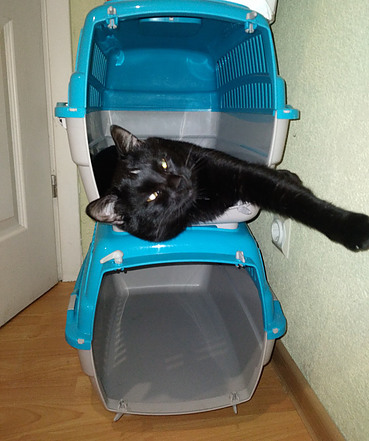
Hello, Cat Enthusiasts!
Carrier training is an important part of cat socialization – it helps to reduce stress during vet visits and travel and it is essential in case of emergency. Today we are going to learn how to carrier train a cat.
Before We Start Training
#1. Start carrier training when your cat is young, if possible. Kittens don’t have negative associations with the carrier and will get accustomed to it easier and in less time.
#2. Clean the carrier to remove any strange smells as they can be a potential source of anxiety.
#3. It may take your cat from weeks to months to get used to the carrier, so start training when you don’t have any scheduled veterinary visits.
#4. Choose the carrier of appropriate size – your cat should be able to stand, sit and turn around in the carrier.
Make the Carrier a Part of Home Environment
If the cat sees its carrier only when its time to travel or visit a veterinarian, it learns to associate the carrier itself with stressful experiences. To prevent or remove these negative associations, it’s important to slowly acclimate the cat to the carrier by keeping it accessible for your cat all the time. Place the carrier with the door off in a room where your cat feels comfortable and regularly spends time and allow it to investigate at its own pace. Over time the cat will habituate to the presence of carrier and stop seeing it as a threat.
Create Positive Associations
Once your cat approaches the carrier without fear, it’s time to convince it that the carrier is not only another familiar object but also a safe and positive place. To encourage your cat to enter the carrier, place a soft familiar bedding inside. You can also put some dry catnip inside or sprinkle the bedding with a catnip or Valerian spray to make the carrier even more attractive. If your cat goes inside to explore, reward it with tasty treats. If the cat seems hesitant, try putting some treats inside and wait for it to retrieve them. Give your cat more treats for staying calm in the carrier.
To make the carrier training more natural and fun you can incorporate it into your cat’s daily routines, such as playtime and mealtime. Play with your cat near and inside the carrier using a laser pointer or wand toys or toss your cat’s favourite toy into the carrier. Once your cat feels comfortable going in and out of the carrier, you can start feeding it in the carrier. Start by offering the food near the carrier and gradually over a number of sessions move the bowl into the carrier. Once your cat is comfortable eating in the carrier, it’s time to get your cat used to being enclosed in the carrier. Begin closing the door during the mealtime for small amounts of time and gradually increase the length of time up to 15-20 minutes. Make the experience more positive by offering treats through the door.
Add Movement
As your cat can stay calm in the carrier with the door closed for longer periods of time, you can begin moving the carrier. Pick up the carrier, take a few steps and reward the cat. Then put the carrier down and open the door. Gradually progress to walking with the carrier around the house. Once your cat tolerates the carrier being moved indoors, you can continue practicing in the outside environment. Practice walking outside, placing the carrier in the car and take your cat for short rides to ensure your cat will stay stress-free during real travel or the next trip to the veterinarian. Keep the process gradual and always reward your cat for calm behaviour.
Final Thoughts
Keep the carrier training positive and rewarding, be patient and give your cat some time to adjust to new situations and build positive associations with the carrier. Ultimately, the carrier should become a secure resting place for the cat. Don’t use one carrier for more than one cats. Don’t put your cat in the carrier if it’s not ready to enter voluntarily and don’t keep the cat inside if it wants to leave the carrier. Clean the carrier after each vet visit to remove strange smells.
If you have something to add or wish to share your own method, please leave a comment.
Thank You For Reading!
